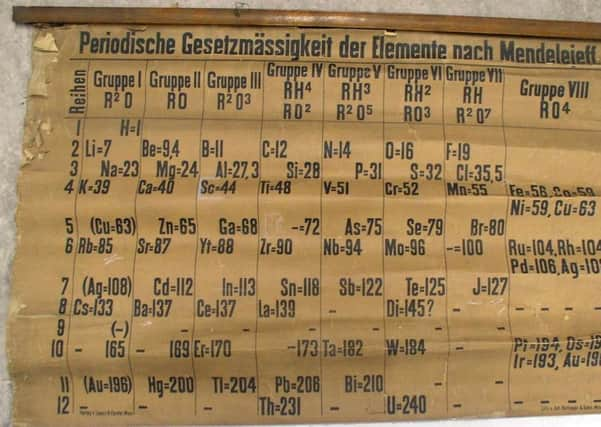World's oldest classroom periodic table found at St Andrews University


The 134 year old chart of elements, dating from 1885, was discovered by Dr Alan Aitken in a storage area full of chemicals and laboratory equipment and that had been accumulating since the opening of the chemistry department in 1968.
The large and extremely fragile periodic table was contained in a stash of rolled up teaching charts and is thought to be the oldest surviving example of a classroom periodic table in the world.Staff at the university have now had the document authenticated, repaired and restored.
Advertisement
Hide AdRussian chemist Dmitri Mendeleev made his famous disclosure on periodicity in 1869. The newly unearthed table was similar, but not identical to Mendeleev’s second table of 1871.
It was clear the St Andrews table was an early specimen and is believed to be the only surviving one from this period across Europe.
The table is annotated in German, and an inscription at the bottom left - ‘Verlag v. Lenoir & Forster, Wien’- identifies a scientific printer who operated in Vienna between 1875 and 1888.
Another inscription - ‘Lith. von Ant. Hartinger & Sohn, Wien’ - identifies the chart’s lithographer, who died in 1890.
Working with the university’s special collections team staff sought advice from a series of international experts.
Professor Eric Scerri, an expert on the history of the periodic table based at the University of California, Los Angeles, dated the table to between 1879 and 1886 - based on the represented elements.
Advertisement
Hide AdBoth gallium and scandium, discovered in 1875 and 1879 respectively, are present, while germanium, discovered in 1886, is not.
The paper support of the chart was fragile and brittle and its rolled format and heavy linen backing contributed to its poor condition.
Advertisement
Hide AdIt has now received a full conservation treatment which included brushing to remove loose surface dirt and debris and separating the chart from its heavy linen backing.
The University’s Special Collections was awarded a funding grant from the National Manuscripts Conservation Trust (NMCT) for the conservation of the chartProfessor David O’Hagan, forme head of chemistry at the university, said: “The table will be available for research and display at the University and we have a number of events planned in 2019, which has been designated international year of the periodic table by the United Nations, to coincide with the 150th anniversary of the table’s creation by Dmitri Mendeleev.”